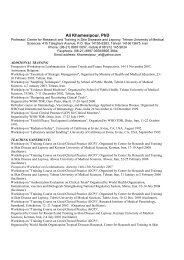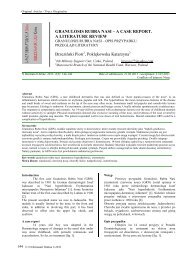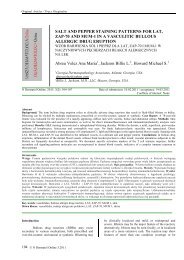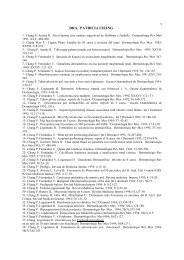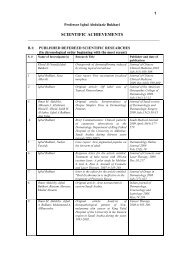15. Dermatology Eponyms â D - like
15. Dermatology Eponyms â D - like
15. Dermatology Eponyms â D - like
Create successful ePaper yourself
Turn your PDF publications into a flip-book with our unique Google optimized e-Paper software.
DICKINSON’S SIGN<br />
Blue saliva. Dickinson describes a women whose saliva<br />
was blue; besides this nothing was definitely the matter<br />
with her. It seemed however, that the color was due to<br />
some chemic-pencil poisoning rather than to a pathologic<br />
process. Paget cites an instance of blue saliva due to<br />
staining the tonuge in the the same manner. Most cases<br />
of anomalus coloring of this kind can be subsequently<br />
traced to artificial substances; unconsciously introduced.<br />
OBJAW DICKINSONA<br />
Niebieska ślina. Dickinson opisuje kobiety, których ślina<br />
miała niebieski kolor, poza tym były zdrowe. Wydawało<br />
się jednak, Ŝe kolor miał związek z pewnym zatruciem<br />
chemikaliami-ołówka, a nie procesem chorobowym.<br />
Paget przytacza przykład niebieskiej śliny ze względu na<br />
barwienia języka w tym kolorze. Większość przypadków<br />
anomalii zabarwienia tego rodzaju moŜe być następnie<br />
nieświadomie wprowadzonych sztucznych substancji.<br />
DIMPLE OR BUTTON SIGN<br />
Sign in dermatofibroma. Lateral pressure produces a<br />
with an overlying depression in the center of the papule.<br />
A central depression or dimple elicited within a lesion<br />
when it is squeezed along its margins.<br />
OBJAW DOŁKA LUB GUZIKA<br />
Objaw w dermatofibroma. Ciśnienie boczne wytwarza<br />
depresję leŜącej w centrum grudki. Wgłębienie lub dołek<br />
wywołany rozpręŜeniem zmiany wzdłuŜ jej brzegów.<br />
WILLIAM HOWSHIP DICKINSON<br />
British physician (1832-1913). He worked at Great<br />
Ormond Street Hospital. He was involved in the early<br />
characterization of what came to be known as Alport<br />
syndrome. Dr Dickinson was physician at the children’s<br />
hospital from 1869 to 1874. He was censor and curator<br />
of the museum at the Royal College of Physicians, and<br />
examiner in medicine to the Royal College of Surgeons,<br />
and to the universities of Cambridge, London and<br />
Durham. Although a general physician, he was best<br />
known as a kidney specialist with regards his adult<br />
patients.<br />
Figure 21. Dimple sign<br />
DIRT EATER’S SIGN<br />
Visceral larva migrans, fever, rash and eye lesions that<br />
mimic retinoblastoma. Infection is from eating dirt with<br />
contains the embryonic eggs of the zoonotic Toxocara<br />
roundworms in dog and cat faeces.<br />
OBJAW ZANIECZYSZCZONEGO JEDZENIA<br />
Larwa wędrująca trzewna, gorączka, wysypka i zmiany<br />
oczne, które naśladują retinoblastoma. ZakaŜenie<br />
następuje po zjedzeniu zanieczyszczonego pokarmu<br />
kałem psów i kotów, zawierającego chorobotwórcze jaja<br />
glisty Toxocara.<br />
Figure 20. William Howship Dickinson<br />
Angielski lekarz (1832-1913). Pracował w Great<br />
Ormond Street Hospital. Brał udział w opisie zespołu<br />
Alporta. Dr Dickinson był lekarzem w szpitalu dla dzieci<br />
1869/74. Był cenzorem i kustoszem muzeum w Royal<br />
College of Physicians, ekspertem w dziedzinie<br />
medycyny w Royal College of Surgeons oraz na<br />
uniwersytetach w Cambridge, Londynie i Durham.<br />
Mimo, Ŝe był lekarzem ogólnym, najbardziej znany był<br />
jako specjalista w zakresie chorób nerek u osób<br />
dorosłych.<br />
DIRTY NECK SIGN<br />
On the sides of neck gray-brown discoloration meshed in<br />
atopic dermatitis.<br />
OBJAW BRUDNEJ SZYI<br />
Na skórze, na bocznych powierzchniach szyi<br />
szarobrązowe, siatkowate przebarwienie w AZS.<br />
164<br />
© N Dermatol Online 3.2011



